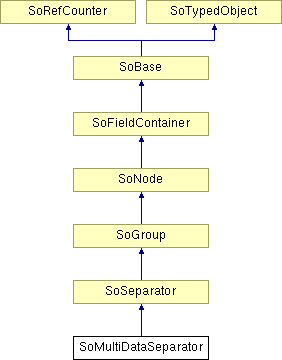SoMultiDataSeparator Class Reference
[Nodes]
 Separator for combining multiple data sets
More...
Separator for combining multiple data sets
More...
#include <LDM/nodes/SoMultiDataSeparator.h>

Public Member Functions | |
| virtual SoType | getTypeId () const |
| SoMultiDataSeparator () | |
Static Public Member Functions | |
| static SoType | getClassTypeId () |
Detailed Description
 Separator for combining multiple data sets
Separator for combining multiple data sets
The SoMultiDataSeparator node allows you to combine multiple data sets.
This is the correct method for combining multiple data sets. Combining multiple data sets without inserting them under an SoMultiDataSeparator node may produce incorrect results and should be avoided.
Each data set is represented by an SoDataSet node (typically an SoVolumeData node). Combining is enabled by an SoDataCompositor node for CPU combining or an SoVolumeShader node for GPU combining. A common use of GPU combining is to implement co-blending of multiple volumes, in other words using a fragment shader to combine the color and/or intensity values of the voxels.
Some rules must be followed when doing render or data compositing:
- Each SoVolumeData node must have a unique SoDataSet::dataSetId.
- All the SoVolumeData nodes to be composited, as well as the compositing node (e.g. SoVolumeShader for slices or SoVolumeRenderingQuality for volumes) and the rendering node (e.g. SoVolumeRender), must be under an SoMultiDataSeparator node.
- The SoVolumeData nodes to be composited must be all scalar data sets or all RGBA data sets. To composite scalar and RGBA data sets under the same SoMultiDataSeparator, set the usePalettedTexture field to false in the scalar dataset's SoVolumeData node to force the scalar data to be converted into RGBA data.
- An SoVolumeData node used in a data compositing scheme must not be inserted multiple times in the scene graph. Use another volume data node pointing to the same file.
- Each SoVolumeData node has its own resource settings (see field SoDataSet::ldmResourceParameters). The resources required for the composition are the sum of the resources for all of the SoVolumeData nodes involved.
*
- All transfer functions must have the same 'colorMapType' and must have the same number of entries in the colormap.
GPU combining must be implemented in a shader program written in the standard GLSL language. The shader program will be specified using an SoVolumeShader node. The shader source code is loaded using (for example) an SoFragmentShader object. Uniform parameters for the shader may be specified using the subclasses of SoShaderParameter. See SoVolumeShader for more information about the shader function library provided by VolumeViz.
It is possible to compose datasets that have different dimensions, tile sizes and transformations.
In order to help fetch the correct data values in custom shaders, texture coordinates conversion functions are provided in the VolumeViz/vvizStructure.h shader include.
See SoVolumeShader for more details.
For each data set there will typically be an SoDataRange node and an SoTransferFunction node to define the mapping from data values to color values. For each SoVolumeData a separate 3D texture will be generated and sent to the GPU. 3D textures can be generated with different precision (8-bit or 12-bit) according to the SoDataSet::texturePrecision field. The texture unit used for each data set is determined by the SoDataSet::dataSetId field. All colormaps are aggregated into a single 2D texture.
A custom fragment shader can retrieve the voxel's data value from each 3D texture using the GLSL VolumeViz function:
VVIZ_DATATYPE value = VVizGetData( dataSetId, texCoord );
A custom fragment shader can lookup the color/intensity for each data value from the appropriate colormap, using the GLSL VolumeViz function:
vec4 color = VVizTransferFunction( value, colorMapId );
A custom fragment shader can then compute (using custom blending functions) the actual color for the voxel and output that color using the GLSL VolumeViz function:
VVizOutputColor( color ):
EXAMPLE
- The following code shows how to do multidata rendering using an SoVolumeShader node to combine values for an SoVolumeRender node. Given two SoVolumeData nodes ds1 and ds2:
SoVolumeShader* volumeShader = new SoVolumeShader(); SoVolumeData* volumeData1 = new SoVolumeData(); volumeData1->dataSetId = 0; SoDataRange* dataRange1 = new SoDataRange(); dataRange1->dataRangeId = 0; SoTransferFunction* colorMap1 = new SoTransferFunction(); SoVolumeData* volumeData2 = new SoVolumeData(); volumeData2->dataSetId = 1; SoDataRange* dataRange2 = new SoDataRange(); dataRange2->dataRangeId = 1; SoTransferFunction* colorMap2 = new SoTransferFunction(); SoVolumeRender* volumeRender = new SoVolumeRender(); SoMultiDataSeparator* multiDataSep = new SoMultiDataSeparator(); multiDataSep->addChild( volumeShader ); // Shader to combine volumes multiDataSep->addChild( volumeData1 ); multiDataSep->addChild( dataRange1 ); multiDataSep->addChild( colorMap1 ); multiDataSep->addChild( volumeData2 ); multiDataSep->addChild( dataRange2 ); multiDataSep->addChild( colorMap2 ); multiDataSep->addChild( volumeRender ); root->addChild( multiDataSep );
SEE ALSO
SoDataSet, SoVolumeData, SoDataCompositor, SoVolumeShader
- See related examples:
-
MedicalCPUDataCompose, MedicalGPUDataCompose, MedicalIntensityAnisotropy, MedicalMultiChannel, MultiChannel_ex1, MultiChannel_ex2, AmplitudeVelocity, CpuDataCompose, GpuDataCompose, HorizonGpuCompose, VVIZ-Template-SG
Constructor & Destructor Documentation
| SoMultiDataSeparator::SoMultiDataSeparator | ( | ) |
Constructor.
Member Function Documentation
| static SoType SoMultiDataSeparator::getClassTypeId | ( | ) | [static] |
Returns the type identifier for this class.
Reimplemented from SoSeparator.
| virtual SoType SoMultiDataSeparator::getTypeId | ( | ) | const [virtual] |
Returns the type identifier for this specific instance.
Reimplemented from SoSeparator.
The documentation for this class was generated from the following file:
- LDM/nodes/SoMultiDataSeparator.h